Cayman Islands Cadet Corps
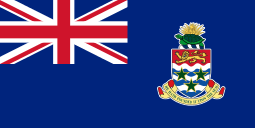 | |
| Name | The Cayman Flag is used by the Cayman Islands Cadet Corps as their Flag. |
|---|---|
| Commandant of the Cayman Islands Cadet Corps | |
|---|---|
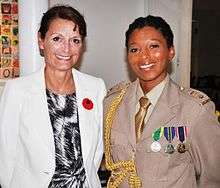 Bobeth Daley O'Garro since 18 July 2013 | |
| Youth and Sports | |
| Style | Lieutenant Colonel (Lt.Col) |
| Reports to | Deputy Governor |
| Residence | Cayman Islands |
| Appointer | Governor of the Cayman Islands with the advice of the Premier |
| Formation | March 2002 |
| First holder | Colonel (Col.) Philip Hyre (Ret) |
| Deputy | Major (Maj.) Ricardo Henry |
| Website | http://www.cicadetcorps.ky/ |
The Cayman Islands Cadet Corps (CICC) is a youth organisation in the Cayman Islands for male and female secondary school students between age 12 and 17. It was established in March 2002.
Core subjects
- Drill and Turnout
- Military Knowledge
- Fieldcraft
- Skill at Arms
- Shooting
- Navigation
- Expedition Training
- First Aid
- Physical Training
- Cadets in the Community
The Cayman Islands Cadet Corps Structure
The CICC is split into 8 detachments:
- John Gray Detachment - 2Lt Griffiths (Alpha)
- Clifton Hunter Detachment - Lt Bennett (Alpha)
- Band Detachment - (Headquarters)
- South Sound Detachment - JG Ebanks (Headquarters)
- Cayman Brac Detachment - Lt Wilston Bennett (Bravo)
- Triple C Detachment - Lt Medford (Bravo)
- Marine Detachment - LSG Thompson (Bravo)
- Section-9 - (S-9)
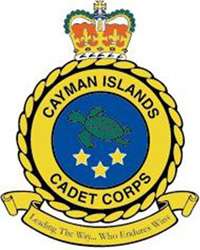
The main objectives of the CICC are defined in its Charter, Vision and the Mission Statement.
The CHARTER
The Cayman Island Cadet Corps is a National Voluntary Youth organisation. It is sponsored by the Governor’s office and administered by a local headquarters led by the Commandant. The Cadet Corps were originally operated by the Ministry of Education with assistance from the RCIPS and provides military style, adventurous, and community activities. The Corps are currently under the Ministry of Health, Environment, Youth, Sports & Culture.
List of Cayman Islands Cadet Commandants and Deputy Commandants
- Commandant Col Philph Hyre (2002 - 2008)
- Deputy Commandant Lt.Col O'Garro (2002 - 2008)
- Commandant Lt.Col O'Garro (2008 - present)
- Deputy Commandant Maj White (2008 - 2017)
- Commandant Lt. Col O'Garro (2008 - present)
- Deputy Commandant Maj Henry (2017 - present)
List of Adjutant Training Officers of the Cayman Islands Cadet Corps
- Adjutant Maj White (2002-2004)
- Adjutant Maj Henry (2004- 2014)
- Adjutant Maj Levy(2015–present)
The (Current) List of Sergeants and Warrant Officers of the Cayman Islands Cadet Corps
- W01 Farley (2010–present)
- W02 Richards (2002–present)
- Ssgt Tibbetts (2010–present)
- CPO Bonilla (2010 present)
- Sgt Ebanks (2010–present)
- Sgt McDonald (2010–present)
- Sgt Alexander(2010–present)
- Sgt Sookoonsingh (2010 present)
Cadet Ranks
As well as learning new skills by working through the APC syllabus, experienced cadets can be awarded a rank. As the Army allows its soldiers to take on responsibility and leadership as Non-commissioned Officers or NCOs, so too does the ACF.
| Insignia |  | 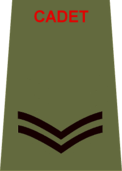 | 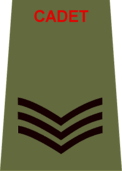 | 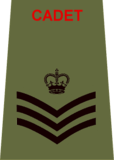 | 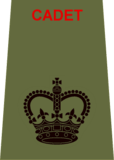 |
|---|---|---|---|---|---|
| Rank | Lance Corporal | Corporal | Sergeant | Staff/Colour Sergeant | Company Sergeant Major |
Cadet NCOs wear the issued cadet rank slides, pictured above.[1] The titles of some ranks may vary as cadet detachments are affiliated to Army regiments and adopt their terminology. There is usually only one Cadet RSM per county. In many counties, there is the opportunity for appointment to Cadet Under Officer (CUO), an appointment allowing the holder to stay in the officers' mess.[2]
Although promotion is based on merit rather than progression through the APC syllabus, the following criteria must be met before a cadet is eligible for promotion:[3]
- Cadet Lance Corporal - Passed APC 1 Star
- Cadet Corporal - Passed APC 2 Star
- Cadet Sergeant - Passed APC 3 Star
- Cadet Staff/Colour Sergeant - Passed APC 4 Star
- Cadet Sergeant Major/Company Sergeant Major - Passed APC 4 Star
- Cadet Regimental Sergeant Major - Master Cadet
- Cadet Under Officer - Master Cadet - May be awarded to a cadet sergeant major who has shown officer potential and is in their last year as a cadet.[4]
Officer Ranks
The following are the insignia - emblems of authority - of the British Army. Badges for field officers were first introduced in 1810 and the insignia was moved to the shoulder boards in 1880 for all officers in full dress.
| NATO code | OF-10 | OF-9 | OF-8 | OF-7 | OF-6 | OF-5 | OF-4 | OF-3 | OF-2 | OF-1 | OF(D) | Student officer | ||||||||||||||||||||||||
|---|---|---|---|---|---|---|---|---|---|---|---|---|---|---|---|---|---|---|---|---|---|---|---|---|---|---|---|---|---|---|---|---|---|---|---|---|
| (Edit) |
 |
 |
 |
 |
 |
 |
 |
 |
 |
 |
 |
.svg.png) |
No equivalent | |||||||||||||||||||||||
| Field Marshal[5] | General | Lieutenant-General | Major-General | Brigadier | Colonel | Lieutenant-Colonel | Major | Captain | Lieutenant | Second Lieutenant | Officer Cadet | |||||||||||||||||||||||||
| Abbreviation: | FM | Gen | Lt Gen | Maj Gen | Brig | Col | Lt Col | Maj | Capt | Lt | 2Lt | OCdt | ||||||||||||||||||||||||
| Typical Command Size or Appointment:[6] | In abeyance | most senior appointments | corps | division | brigade or director of operation capability on staff | Rarely a Field Command except in RAMC. Usually lowest staff officer as principal operational advisers | battalion | company/battery/ squadron | company/battery/ squadron (second in command) or leader of smaller specialised team | platoon | platoon | |||||||||||||||||||||||||
| Typical promotion to after:[7] | 8–10 years | 5 years (university graduates 3 years) | 12–24 months | 44 weeks officer training | ||||||||||||||||||||||||||||||||
History
The Cayman Islands premier has stated the desire to raise a Cayman Islands Defence Force when it can be afforded, which would make the Cayman Islands the fifth British Overseas Territory to have a locally raised army unit, but for the moment it has only the Cayman Islands Cadet Corps.
The CICC was established in 2001 and enacted by the Cayman Islands Cadet Corps Law of 2003. The First Commandant of the CICC, now retired, was Colonel Philip Hyre. In 2013, Lieutenant Colonel Bobeth O’Garro was confirmed as the Commandant for the CICC, thus becoming the first female Commandant to lead a Corps in the Caribbean region.[8]
Syllabus
The Organisation has been modeled on the UK Army Cadet Force organisation (ACF). The organisation aims to provide citizenship training via military-style activities, including instruction in military knowledge, drills, leadership, public speaking, field craft, land and sea navigation, signaling, physical fitness, first aid, arms skills, and music.
Cayman Islands
The Cayman Islands is a British Overseas Territory and uses the same school curriculum as the UK. In September 2005 the CICC began working with the Cadet Vocational Qualification Organisation (CVQO) in the UK to add a vocational training element that has resulted in qualified cadets gaining the BTEC First Diploma in Public Services, which is equivalent to passes in four subjects at GCSE. The CICC became the first Cadet Corps in the Caribbean to offer such a diploma.
The CICC has an overseas exchange program with UK, Canada and other Caribbean Islands.
References
- ↑ Army Dress Regulations (All Ranks), Part 08 "Dress Regulations for Combined Cadet Force (Army Sections) and the Army Cadet Force", Ministry of Defence, April 2013
- ↑ AC 14233 The Army Cadet Force Manual (2012 Edition), Paragraph 6.014
- ↑ AC 14233 The Army Cadet Force Manual (2005 Edition), Paragraph 6.012
- ↑ "Cadet Ranks". Retrieved 2 March 2014.
- ↑ Title; Honorary or posthumous rank; war time rank; ceremonial rank
- ↑ "British Army Website: Ranks". Retrieved 3 November 2013.
- ↑ "British Army Website: Officer careers". Retrieved 3 November 2013.
- ↑ http://www.caymannewsservice.com/local-news/2013/07/18/first-female-commandant-caribbean
External links
- Cayman Islands Cadet Corps homepage
- http://www.armycadetexchange.com/pages/cayman/2008/history-cadet-corps.pdf
- http://www.caycompass.com/cgi-bin/CFPnews.cgi?ID=1024195